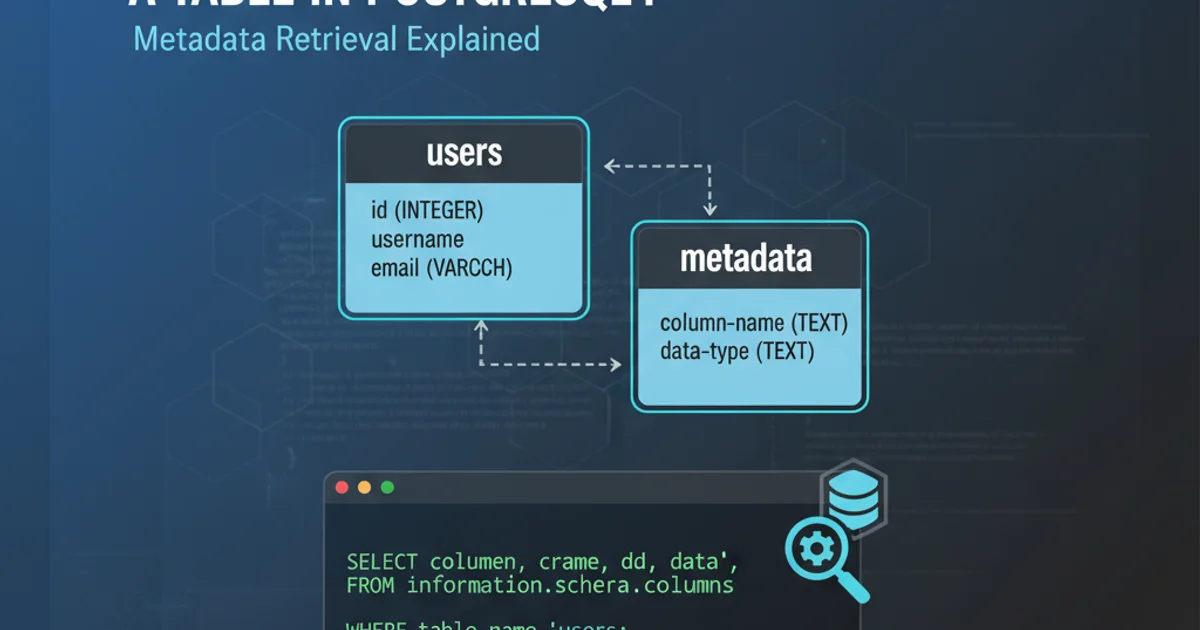How to get a list column names and datatypes of a table in PostgreSQL?
How to List Column Names and Data Types in PostgreSQL

Learn various SQL queries and commands to retrieve detailed schema information, including column names and their corresponding data types, for any table in a PostgreSQL database.
Understanding the structure of your database tables is fundamental for effective data management and application development. In PostgreSQL, there are several powerful ways to inspect table schemas, allowing you to retrieve column names, their data types, and other crucial metadata. This article will guide you through the most common and efficient methods, from simple SQL queries to using PostgreSQL's built-in catalog views.
Using \d Command in psql
For quick interactive inspection within the psql command-line client, the \d command (describe) is incredibly useful. It provides a concise summary of a table's structure, including column names, types, and modifiers like NOT NULL.
\d your_table_name;
Using the \d command in psql to describe a table.
\d command is a psql meta-command, not standard SQL. It's excellent for interactive use but cannot be executed from external applications or programming languages.Querying the information_schema
The information_schema is a standard SQL feature that provides a set of views containing metadata about the objects in your database. It's a portable way to query schema information across different SQL-compliant databases, though its implementation details might vary slightly. To get column names and data types, you'll typically query the information_schema.columns view.
SELECT
column_name,
data_type,
character_maximum_length
FROM
information_schema.columns
WHERE
table_schema = 'public' AND table_name = 'your_table_name';
Retrieving column details using information_schema.columns.
'public' with your actual schema name if your table is not in the default public schema, and 'your_table_name' with the name of the table you're inspecting.Querying PostgreSQL System Catalogs
PostgreSQL maintains its own set of system catalog tables that store all database metadata. These catalogs offer the most comprehensive and detailed information about your database objects. While information_schema is more portable, directly querying system catalogs like pg_catalog.pg_attribute and pg_catalog.pg_class can sometimes provide more specific PostgreSQL-centric details or better performance for very large schemas. This method requires joining several catalog tables.
SELECT
a.attname AS column_name,
pg_catalog.format_type(a.atttypid, a.atttypmod) AS data_type
FROM
pg_catalog.pg_attribute a
JOIN
pg_catalog.pg_class c ON a.attrelid = c.oid
JOIN
pg_catalog.pg_namespace n ON c.relnamespace = n.oid
WHERE
n.nspname = 'public' AND c.relname = 'your_table_name' AND a.attnum > 0 AND NOT a.attisdropped
ORDER BY
a.attnum;
Using PostgreSQL system catalogs to get column names and data types.
erDiagram
"pg_catalog.pg_class" ||--o{ "pg_catalog.pg_attribute" : "has attributes"
"pg_catalog.pg_namespace" ||--o{ "pg_catalog.pg_class" : "contains tables"
"pg_catalog.pg_class" {
oid relid PK
text relname
oid relnamespace FK
}
"pg_catalog.pg_attribute" {
oid attrelid FK
text attname
oid atttypid
int atttypmod
int attnum
boolean attisdropped
}
"pg_catalog.pg_namespace" {
oid oid PK
text nspname
}Simplified ER Diagram of PostgreSQL System Catalogs for Schema Information
pg_catalog tables is powerful but less portable than information_schema. The structure of these tables can change between PostgreSQL versions, though pg_catalog.format_type is generally stable for type formatting.Choosing the Right Method
The best method depends on your specific needs:
\dcommand: Ideal for quick, interactive checks withinpsql.information_schema.columns: Recommended for programmatic access and when portability across SQL databases is a concern. It's generally easier to read and understand.pg_catalogviews: Use when you need the most detailed, PostgreSQL-specific metadata, or wheninformation_schemadoesn't provide sufficient detail for a particular use case. It offers the most granular control but comes with increased complexity and reduced portability.